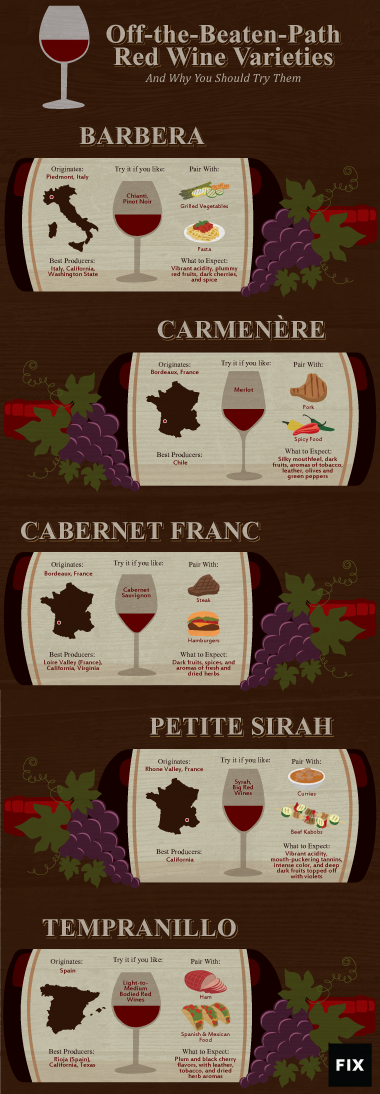Off-the-Beaten-Path Red Wine Varieties
And Why You Should Try Them
Let’s face it – sometimes relationships just get stale. When that happens, it often helps to take a short break,
spend some time away, or inject something new and fresh into the routine.
We’re not talking about your relationship with a spouse or significant other:
we’re talking about your relationship with wine. When it comes to red wines,
the ubiquitous choices of Cabernet Sauvignon, Merlot, Syrah, Pinot Noir, or even Tuscan Chianti
can start to seem a little boring. We love those wines for good reasons, but just as
with any relationship, it often helps to take a breather and try something new.
Fortunately, the wine world is ripe with alternative choices, at just about
every price point imaginable. In fact, there has never been a better time
to be a wine lover in search of something new. Here are a few off-the-beaten-path
red wine grape varieties that can get you started on your hunt for something
a bit more exotic than the normal fare on the wine store shelf.
Barbera
You could think of Barbera as a bit like a robust Pinot Noir sporting
a dark Mediterranean tan and speaking in a thick, sexy Italian accent. Barbera
is native to Italy, and does best in that country’s Piedmont region.
Its hallmarks are aromas of plums and spices, and flavors of dark cherries.
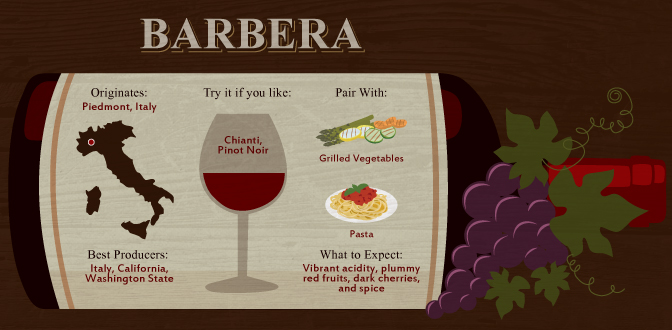
Carmenère
For most of its life, Carmenère was little more than a blending grape in its home of Médoc
(in France’s Bordeaux region), and in the 1800s was nearly wiped out by vine pests.
But the grape eventually found its way to South America, and in Chile’s unique vine-growing
conditions Carmenère began to thrive. Today, Chile is the world standard in Carmenère wines.
Initially, Chilean wine growers confused Carmenère with Merlot, and it does
share many similarities with that grape, making it a good alternative for
those who enjoy Merlot, but feel that they need a change. Carmenère has a similar deep red color,
and like Merlot often has aromas of black olives and green peppers along with its red berry fruit flavors.
Just as Merlot has a softer, rounder mouthfeel, Carmenère has a silkiness on the palate,
making it a nice complement to pork dishes, and even spicy cuisine.
What makes Carmenère a bit different (and therefore, a little more exotic) than the more
ubiquitous Merlot? Its slightly lighter body, lower alcohol content, and aromas
of leather and tobacco.
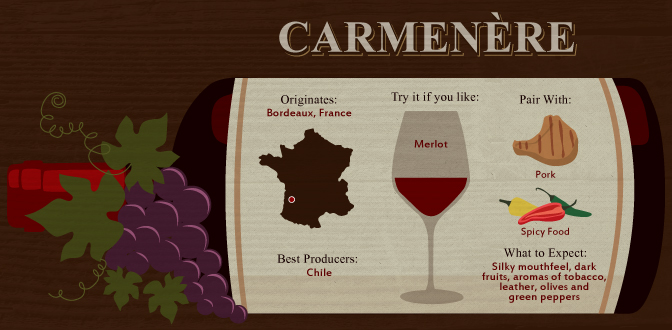
Cabernet Franc
Cabernet Franc, a native of France, is like Cabernet Sauvignon’s little sister. It has
some of the tell-tale Cabernet Sauvignon aromas and flavors – red and black fruits, spices,
fresh herbs – but dials back the mouth-puckering tannins into something that feels just a bit more feminine.
Cabernet Franc is a nice pick if you love Cabernet Sauvignon, but want to switch
things up and experience Cabernet’s softer side. This grape is often described as having
raspberry and violet aromas, which act as a nice counterpoint to the wine’s darker fruits.
Like Cabernet Sauvignon, Cabernet Franc is a good match for meat dishes of any kind,
from high-end steakhouse fare to burgers from the grill. It’s a grape that travels well,
too, yielding interesting wines in France’s Loire Valley, California’s Napa Valley, and Washington and Virginia.
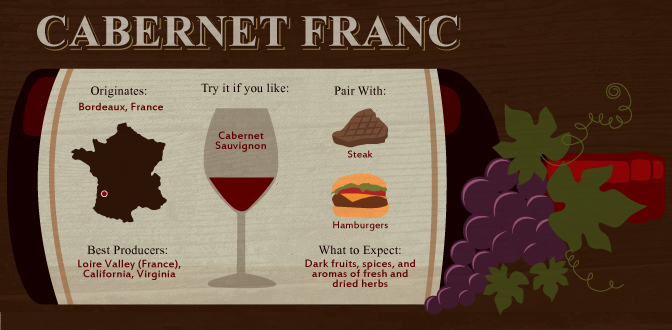
Petite Sirah
Do you prefer your red wines to be big, brash, and bold? If so, there’s probably a Californian Petite Sirah
wine out there for you. Petite Sirah is inky-dark, with a deep, dark, teeth-staining purple hue.
Its aromas are quite soft, and include perfume, chocolate, violets, and blackberry fruits
(making it somewhat similar to the more common Syrah, which is a different grape).
But that softness is a bit of a ruse, and Petite Sirah is a trickster: on the palate,
it’s domineering, with black fruit flavors, vibrant acidity, and strong, bitter tannins.
This grape often makes “full-throttle” wines that are not just full-flavored, but are also full-bodied.
While that isn’t typically a quality you’d think to match with spicy cuisine, Petite Sirah is
surprisingly versatile with curry dishes, and seems almost tailor-made for beef kabobs.
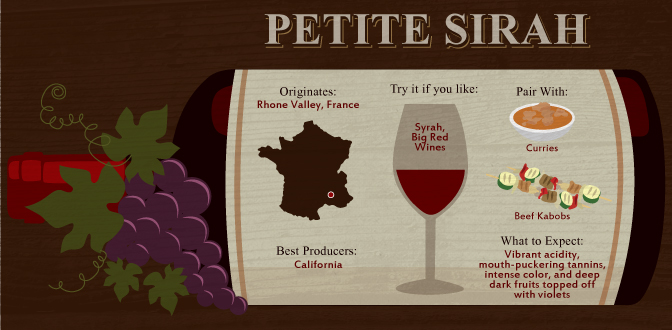
Tempranillo
A common grape across Spain (and used as one of the blending grapes for the fortified
wine Port in neighboring Portugal), Tempranillo might just hold the record for the
grape with the most aliases. It is known by nearly 70 different names!
No matter what it’s called, Tempranillo is a potential blockbuster of a wine, particularly if
you’re fond of light-to-medium-bodied red wines and want an alternative with a mysterious flair
about it. In Spain’s Rioja, where Tempranillo achieves its greatest potential, it can produce
wines that are delicious to drink now, but that can also age for decades. This versatile grape
can be crafted into vibrant Rosé-style wines, fresh and fruity “young” wines, or earthy, demanding,
spicy, and exotic reds meant for aging in the cellar. Spanish Tempranillo also remains one of the
biggest bangs for the buck in the wine world when it comes to the quality you can get for the price.
After its success in Spain, Tempranillo has become a globe-trotter, taking root in
California, Texas, Argentina, and even Thailand. No matter what style you prefer,
Tempranillo will almost always have a medium body, vibrant dark cherry and red plum flavors,
and aromas of dried herbs and tobacco. Tempranillo is a natural match for Spanish-inspired cuisine
like tapas, but does equally well with ham dishes and all but the spiciest Mexican foods.
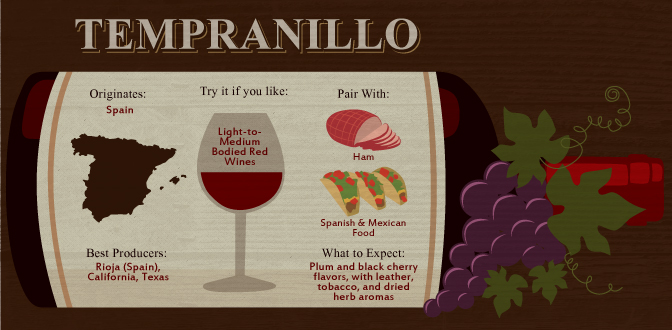
It’s time to freshen up your relationship! Bench your Merlot or Cabernet Sauvignon and try something new!
There is a whole world of red waiting to be tasted! If you feel like you’re facing the same wine rut
with white wine, don’t be afraid
to branch out! Just like red wines, there are many new white varieties waiting to be discovered.
You already know the basics, now it’s time to treat your taste buds and take your wine knowledge to the next level!
Embed the article on your site
